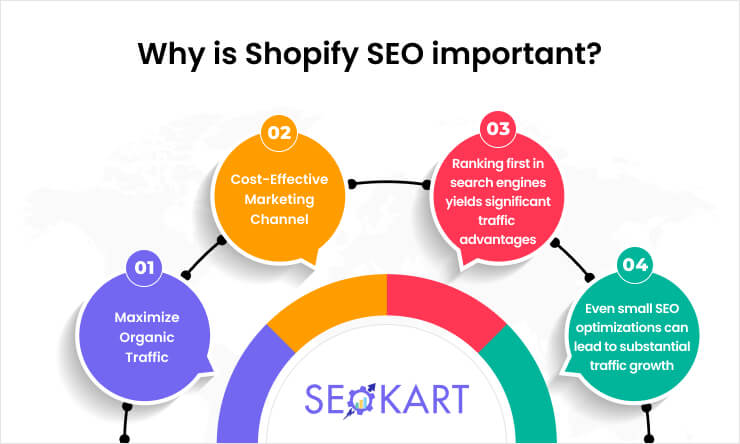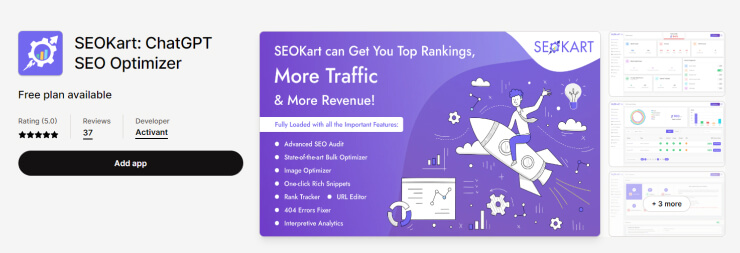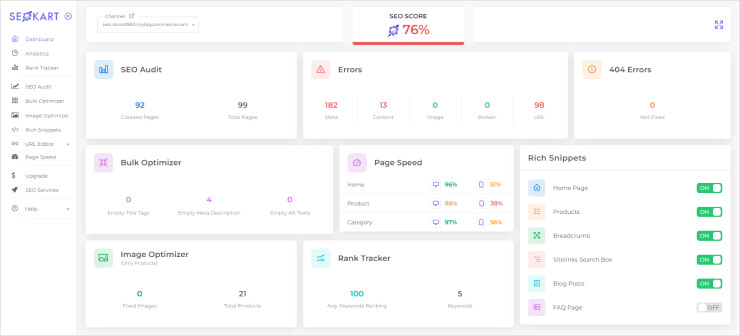Complete Shopify SEO Guide (2025)
Want to reach your target customers faster? Here’s a guide on Shopify SEO to tap into the search engine to increase your sales this year.


Want to reach your target customers faster? Here’s a guide on Shopify SEO to tap into the search engine to increase your sales this year.

Did you know that around 63% of people initiate their shopping journey by searching on search engines?
In order for your brand to be discovered in the vast digital landscape, you need more than just a great product or an appealing website. This is where the power of SEO comes into play.
Having a solid SEO strategy for your Shopify store is essential to ensure visibility and attract potential customers.
In this comprehensive guide, we will walk you through the world of Shopify SEO, provide you with actionable insights and techniques to improve your store's search engine rankings and drive organic traffic.
Shopify SEO refers to the practice of optimizing your Shopify store to improve its visibility and ranking in search engine results pages (SERPs). It involves implementing various strategies and techniques to ensure that your online store appears higher in search engine rankings when relevant keywords are searched.
When someone searches for a product or service related to your Shopify store, you want your website to be among the top results.
By focusing on Shopify SEO, you can increase the chances of your store being discovered by potential customers, drive organic traffic, and ultimately boost your sales.
To achieve effective Shopify SEO, it's important to pay attention to several key factors.
These include optimizing your website's structure, ensuring proper keyword usage, optimizing product descriptions and metadata, improving page load speed, and acquiring quality backlinks from reputable websites.
Shopify SEO holds immense importance in the success of your online store. Here are a few key reasons why focusing on SEO for your Shopify store is crucial:

Organic search traffic accounts for a significant portion of overall website visits, with studies showing that approximately 35% of total traffic to online stores comes from search engine results pages (SERPs).
By implementing effective Shopify SEO strategies, you can tap into this valuable source of traffic and attract potential customers who are actively searching for products or services like yours.
While paid advertising can generate immediate results, it often comes with increasing costs that can eat into your profit margins.
In contrast, SEO is often referred to as "free traffic" because it doesn't require direct payment for clicks.
Although it may take time and effort to see the full benefits of SEO, the long-term impact and compounding effect make it a sustainable and cost-effective acquisition channel for generating customers.
Securing the top position in search engine rankings can significantly impact your website's traffic.
Studies indicate that being ranked first in search engine results can result in up to 30% more daily traffic compared to lower-ranking positions. The difference in click-through rates between the first and eleventh positions is considerable.
By implementing effective SEO strategies, you can improve your store's rankings and increase the likelihood of attracting more visitors and potential customers.
If you have pages on your Shopify store that are already driving organic traffic without any intentional SEO efforts, there is tremendous potential for improvement.
Even the smallest tweaks or targeted optimizations can result in a significant increase in traffic. By identifying and optimizing these pages, you can further enhance their performance and capitalize on their existing visibility to drive even more traffic and potential conversions.
Getting started with Shopify SEO doesn't have to be overwhelming. Here are some essential steps to help you kickstart your SEO efforts for your Shopify store:

To set your Shopify store up for SEO success, it's important to follow a comprehensive checklist.
Here's a closer look at each step, ensuring you have all the essential elements in place:

Boost your store's visibility by using Google Search Console, a powerful tool that helps you monitor website traffic, track search performance, and identify potential issues that might affect your rankings.
Sign up for an account and verify your domain to gain access to these valuable insights. With Google Search Console, you'll have a deeper understanding of how your store is performing in search results.
Don't overlook the potential of Bing, the second-largest search engine in the United States. Create an account with Bing Webmaster Tools, a free service provided by Microsoft, and add your Shopify store to their crawler.
This step ensures that your website appears in Bing's search results, capturing additional organic traffic.
Help search engines better understand and navigate your website's structure by submitting a sitemap. Shopify automatically generates a sitemap for your store, which lists all individual pages. You can find your store's sitemap just by adding "sitemap.xml" to the end of the your store's URL. For example, "https://www.yourstore.com/sitemap.xml". This works for most of the websites, but not for all.
Submit this sitemap to both Google and Bing through their respective Webmaster Tools accounts. By doing so, you increase the chances of your pages being indexed and ranked accurately.
Gain valuable insights into user behavior, engagement, and traffic patterns with Google Analytics 4.
Set up an account and add your website to start tracking and analyzing how visitors interact with your store.
From tracking the number of visitors from search engines to monitoring the performance of specific landing pages, Google Analytics 4 provides you with actionable data to refine your SEO strategies and improve the overall user experience.
Staying on top of SEO trends and competitor analysis is crucial for the success of your online business. But looking into everything from keyword research to ensuring every element of your online store is well-optimized, can be overwhelming.
This is where using the best Shopify SEO apps like SEOKart can come in handy.

The all-in-one SEO Optimizer App is powered with ChatGPT (AI Assist) and specially designed for Shopify merchants, taking into account the platform’s strengths and weaknesses to simplify setting up SEO strategies.
Shopify offers built-in SEO features that simplify optimization for your store.
These features include automatically added canonical tags to prevent duplicate content issues and the generation of robots.txt files and sitemap.xml.
To further enhance your SEO efforts, consider installing apps such as SEOKart. The app provides additional optimization tools like SEO audits, broken link fixing, redirect management, and optimization of HTML title tags and meta tags.
Install the all-in-one Shopify SEO optimizer app here.
Ensure that search engines have successfully indexed your website to ensure its visibility in search results. Perform a site search using the "site:yourdomain.com'' command to see if your pages are indexed.
Keep in mind that indexing can take some time, especially for new websites. If you find that your site isn't indexed, consider submitting your sitemap and monitor the progress.
The SEOKart site audit feature can help you uncover indexing related issues and errors easily.

Technical SEO plays a crucial role in ensuring that search engine crawlers can access and understand your website while providing a positive user experience.
Follow this technical SEO checklist to optimize your website's technical aspects and enhance its ranking potential:

Google prioritizes mobile-friendly websites in its search engine rankings. Ensure that your website is responsive and provides a seamless experience across different mobile devices.
If you're using Shopify, rest assured that all themes on the Shopify Theme Store are mobile-friendly. For non-Shopify websites, use tools like Google's Mobile-Friendly Test to assess your website's mobile optimization.
Secure your website with SSL certification and an HTTPS domain. Search engines consider secure websites as trustworthy and rank them higher in search results.
SSL encryption protects user data and ensures a safe browsing experience, making it crucial for e-commerce sites, blogs, and affiliate websites.
Page load speed is a vital ranking factor for both desktop and mobile searches. Optimize your website's performance by running it through tools like Google PageSpeed Insights or just using SEOKart instead.
Implement the recommended optimizations, such as deferring offscreen images, reducing unused JavaScript, and properly sizing images, to improve your website's loading speed.
Regularly check for crawling errors using Google Search Console or Shopify SEO app, SEOKart.
Broken links hinder search engine crawlers' ability to index your website.
Fix any broken links promptly by redirecting inactive pages to relevant, active pages. This ensures a smooth user experience and helps search engines navigate your website effectively.
Internal linking is a powerful SEO tactic that enhances your website's visibility and search engine rankings.
Strategically link relevant pages within your website to improve topical authority and categorize your content.
For an e-commerce store, link related products on product pages. If you have a blog, internally link to other articles that provide more in-depth information on specific topics.
Anchor text, the clickable text within a hyperlink, provides context to search engines about the linked page's content.
Diversify your anchor text strategy by using a combination of exact match, partial match, related terms, branded, and page title anchor texts.
This approach helps search engines understand the relevance of the linked page to specific search queries.
Your website's navigation serves as a guide for visitors and search engine crawlers, indicating the importance of various pages.
Optimize your global navigation by including important links to key pages, such as your blog, product pages, or landing pages.
Choose a navigation style that best suits your website, whether it's a single-bar navigation, double-bar navigation, or dropdown navigation.
To ensure that your individual web pages have the best chance of ranking well and competing with established brands, it's crucial to optimize them effectively.
Follow this on-page SEO checklist to make sure your pages are fully optimized and ready to attract organic traffic:

Utilize keyword research tools like Google Keyword Planner and Google Trends to determine the search volume of keywords and generate keyword ideas.
Shortlist keywords that your target audience is likely to search for and analyze the search intent behind each keyword.
Map these keywords to different content types on your website, such as product pages, categories, blog posts, and the homepage.
Remember, each page can rank for different keywords based on their specific purpose.
Heading (H1) tags serve as the main headline for a page and typically contain the page's primary keywords.
Search engines rely on these tags to understand the context of a page. While it's best practice to include only one H1 tag per page, you may consider split-testing the number of H1 tags for larger websites.
It's worth noting that Shopify page titles serve as the default H1 tag for pages created through the platform.
Title tags play a crucial role in attracting users to click on your page from search results.
Craft compelling and human-readable titles that clearly describe the content on your page, include important keywords, and entice users to click.
Keep your title tags under 60 characters in length, as title tags with 40 to 60 characters tend to have the highest click-through rates. Additionally, place your main keywords near the beginning of the title tag to encourage click-throughs and demonstrate relevance to search engines.
Meta descriptions are short snippets of text that appear below the title tag in search engine results.
These descriptions provide an opportunity to clearly describe your page's content and entice users to click.
Aim to include your target keywords and compelling copy at the beginning of the meta description.
While there's no exact character count for meta descriptions, it's advisable to keep them under 155 characters to avoid truncation.
URLs play a role in conveying the content of your page to search engines and users. Include your target keyword in the URL while keeping it concise and avoiding filler words.
Make your URLs readable, use hyphens instead of underscores, and ensure that they provide a clear indication of the content on the page.
Aim for simplicity and human understandability in your URL structure.
To enhance the visibility of your images in search results, use descriptive file names instead of generic ones like "83798.jpg".
Additionally, provide descriptive alt text that explains the content of each image.
This practice not only helps search engines understand the image but also ensures accessibility for visually impaired users.
Implementing Schema markup on your website helps search engines better understand your content and can lead to enhanced search result displays.
Schema markup structures data in a specific way that enables page information to appear directly in search engine results, increasing click-through rates and driving more traffic to your website.
Consider using Schema markup for various elements, such as product ratings, reviews, and frequently asked questions (FAQs), to enrich your search results.
When it comes to boosting your website's visibility and climbing the search engine rankings, off-page SEO is a game-changer.
Building quality backlinks from trusted websites can enhance your domain authority (DA) and establish your website as a competitive force.
So, let's dive into this off-page SEO checklist and unlock the potential of link building.

Look into the sites and directories that are linking to online stores selling products similar to yours.
Study the context and understand why these sites chose to link to them. This valuable insight can guide your partnership-building efforts and help you create a compelling case for others to link to your website.
This could also unlock new partnership opportunities or give more direction to your affiliate marketing program in the long run.
Forge partnerships that offer mutual benefits by providing value to other websites. Identify influencers and bloggers in your niche who could benefit from your expertise or products.
Reach out to them and propose guest posting opportunities.
In exchange for providing valuable content, you'll receive a backlink in the author bio section. Search for relevant websites using terms like "[niche] + 'write for us'" or "[niche] + 'guest post'."
Journalists are always on the lookout for newsworthy stories.
Establishing relationships with journalists can help you secure press coverage on authoritative websites, earning you strong backlinks.
Consider participating in awards or competitions, distributing press releases, supporting social causes, or sending product samples to writers.
Platforms like HARO (Help a Reporter Out) can also connect you with journalists actively seeking expert opinions.
Monitor your brand's online presence using brand monitoring tools. Identify instances where your store or products are mentioned but not linked to your website.
Politely reach out to the writer or publication and request that they turn the mention into a clickable link. This simple step can maximize the potential of your brand's online exposure.
Another way to get your brand noticed is to be present where your target audience is actively engaging in discussions.
From Quora, Reddit to other online communities, forums and groups, focus on addressing consumer queries and helping them find the right products.
As the dynamics of search engines continue to evolve, it is crucial for ecommerce businesses to prioritize understanding consumer intent in order to drive relevant organic traffic to their stores.
With the ever-increasing competition in the digital landscape, harnessing the power of SEO becomes even more essential.
This is where SEOKart comes into play.
SEOKart is a powerful Shopify SEO app designed to assist businesses in optimizing their SEO strategies.
With features that enhance website performance, improve keyword targeting, and provide valuable insights, SEOkart empowers businesses to elevate their search engine rankings and drive more organic traffic.
To unlock the full potential of SEOKart and revolutionize your ecommerce SEO, take the next step and book a demo or install the app today.
Shopify SEO refers to the practice of optimizing a Shopify store to improve its rankings on search engine results pages. This includes technical optimization, keyword research, and improving user experience.
To improve SEO on Shopify, focus on keyword research, optimizing meta tags, improving website speed, and acquiring backlinks. Tools like SEOKart can help automate and streamline the process.
Yes, Shopify offers several built-in SEO tools and supports third-party apps like SEOKart to enhance SEO efforts. It’s considered a strong platform for search engine optimization.
SEOKart, Ahrefs, and SEMrush are some of the top tools for Shopify SEO. They offer features for keyword research, audits, and backlink tracking.
Shopify SEO costs can vary based on whether you hire an expert, use apps, or manage it in-house. Apps like SEOKart offer affordable solutions starting at $29/month.